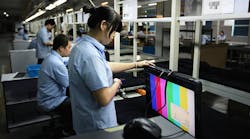China’s official factory gauge unexpectedly strengthened this month, signaling some resilience as the economy braces for an escalation of the trade war with the U.S.
The manufacturing purchasing managers index stood at 51.3 in August versus 51.2 in July and exceeded the forecast of 51 in a Bloomberg survey of economists. The non-manufacturing PMI, covering services and construction, also rose to 54.2, the statistics bureau said Friday, compared with 54 in July. Levels above 50 indicate improvement.
With the U.S. already raising tariffs on $50 billion of Chinese goods, such strength may prove difficult to sustain, and levies on another $200 billion may be imposed as soon as next week. That said, government measures to ensure the supply of credit and stoke investment in infrastructure may be already brightening the outlook among businesses at home.
“The nation’s pro-growth measures have taken effect to stabilize sentiment," said Ding Shuang, chief economist for Greater China and North Asia at Standard Chartered Plc., who accurately forecast the PMI this month. Ding cited more proactive fiscal policy, tax cuts, expedited bond sales and better credit access for smaller companies.
The onshore yuan climbed 0.15% to 6.8339 to the dollar as of 10:51, after the People’s Bank of China set a stronger-than-expected daily reference rate. The Shanghai Composite Index dropped 0.5%, while the Hang Seng Index declined 1.2%.
China announced Thursday that it will exempt foreign institutions from paying some taxes on interest gains in the onshore bond market as part of efforts to support the economy. The exemption announced after a State Council meeting presided over by Premier Li Keqiang covered corporate income and value-added taxes for a period tentatively set at three years.
The reading for smaller manufacturers rose to 50 in August after remaining in the deterioration zone for three months, highlighting that central bank policies to support that vital part of the economy may be helping to underpin confidence. The reading for larger companies edged lower for a third month, though was still at a robust level of 52.1.
“Steady production and new domestic orders outweighed weaker new export orders,” Morgan Stanley economists including Jenny Zheng wrote in a note. “The economy could remain on a path of soft landing, as defensive easing measures could boost infrastructure investment and cushion potential impact from trade tensions.”
The official PMI result runs counter to some leading data as collated by Bloomberg Economics’ deck of early indicators. That showed output weakening again in August, as demand from key trading partners softened and sentiment among stock investors worsened.
"This quarter and the next three are going to be pretty weak," said Andrew Polk, co-founder of research firm Trivium China in Beijing. "Infrastructure investment is just so low it’s going to be a real challenge for them to get that unstuck. There’s not enough shovel ready projects so they can dump in all the bond financing for local governments. That money’s not going to be deployed very quickly."
External Demand
Risks to external demand from the trade tensions appeared in the data, highlighting the uncertainties for Chinese factories. President Donald Trump wants to move ahead with a plan to impose tariffs on $200 billion in Chinese imports as soon as a public-comment period concludes next week.
New export orders dropped to 49.4, the lowest level since February, when the Chinese New Year disrupted production.
By Bloomberg News



